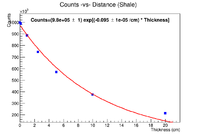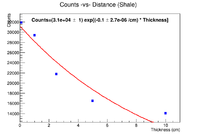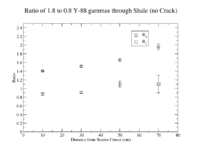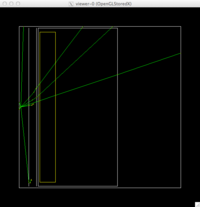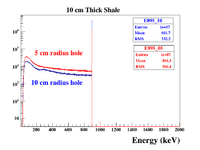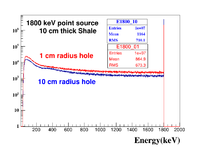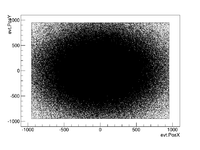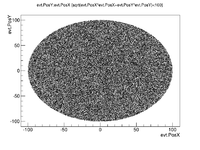Difference between revisions of "TF IsotopeTracers4Cracks"
| Line 84: | Line 84: | ||
==Rates== | ==Rates== | ||
| − | ==Surface rates -vs- Crack size== | + | ===Surface rates -vs- Crack size=== |
The crack size decreases as you move from left to right in the table. | The crack size decreases as you move from left to right in the table. | ||
| Line 92: | Line 92: | ||
{| border="1" |cellpadding="20" cellspacing="0 | {| border="1" |cellpadding="20" cellspacing="0 | ||
|- | |- | ||
| − | |[[File:TF_100mmCrack_XvsY.png]] || [[File:TF_50mmCrack_XvsY.png]]|| [[File:TF_10mmCrack_XvsY.png]]|| [[File:TF_5mmCrack_XvsY.png]]|| [[File:TF_1mmCrack_XvsY.png]] | + | |[[File:TF_100mmCrack_XvsY.png| 200 px]] || [[File:TF_50mmCrack_XvsY.png| 200 px]]|| [[File:TF_10mmCrack_XvsY.png| 200 px]]|| [[File:TF_5mmCrack_XvsY.png| 200 px]]|| [[File:TF_1mmCrack_XvsY.png| 200 px]] |
|- | |- | ||
|100 mm hole|| 50 mm hole||10 mm ||5 mm|| 1 mm | |100 mm hole|| 50 mm hole||10 mm ||5 mm|| 1 mm | ||
Revision as of 16:29, 10 April 2013
Definition of Shale
Shale was assumed to have the chemical composition of
and a density of 2.6 g/
G4Element* O = new G4Element("Oxygen" , "O", z=8., a= 16.00*g/mole);
G4Element* Al = new G4Element("Aluminum" , "Al", z=13., a= 26.98*g/mole);
G4Element* Si = new G4Element("Silicon" , "Si", z=14., a= 28.085*g/mole);
G4Element* H = new G4Element("Hydrogen" , "H", z=1., a= 1.008*g/mole);
G4Material* Shale = new G4Material("Shale", density= 2.6*g/cm3, nel=4);
Shale->AddElement(Al, 15*perCent);
Shale->AddElement(Si, 15*perCent);
Shale->AddElement(O, 38*perCent);
Shale->AddElement(H, 32*perCent);
Photon Attenuation in Shale
According to the XCOM database, the attenuation length for a 1.8 MeV photon is 0.16 /cm and 0.895 is 0.22/cm through shale.
File:XCOM attenuation4Shale.pdf
Directing a 1.8 MeV beam of photons in GEANT4 towards various thicknesses of shale produced the graph below.
XCOM predicts an attenuation coefficient of 0.0441 cm^2/g which becomes 0.12/cm when you multiply by the shale density of 2.6 g/cm^3. The fit to GEANT4's predictions above produces a value of 0.1/cm when you plot the number of photons that pass through the shale and still have an energy of 1.8 MeV.
If I use a point source isotropically emitting 1800 keV photons I observe
which gives a the value of 0.1/cm as well.
Yittrium in Shale
A simulation of the penetration of the 0.895 and 1.8 MeV photons from Yittrium through shale.
GEANT4 create a point source or 895 keV photon and another with 1800 keV photons iostropically distributed.
A 4" thick piece of shale was placed between the source and the detector.
Two ratios were constructed.
Insert a single crack
A simulation was performed that predicted the transmission of photons through 10 centimeters of shale. The shale is in the form of a cylinder with a hole through the central axis.
The source was a uniform points source. One set of simulations used a 1.8 MeV photon and another used a 0.895 photon.
Energy distribution
Position Distribution
The Shale is a cylinder and the detector is a rectangle. A cut is used to look only at photons within the cylinder.
Units are Centimeters.
Rates
Surface rates -vs- Crack size
The crack size decreases as you move from left to right in the table.
The result below is from a 1800 keV uniform point source and a 10 cm thick shale wall with a cylindrical hole through the center (X=0:Y=0)
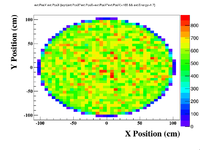 |
200 px | 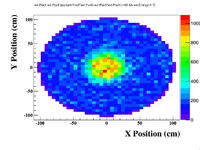 |
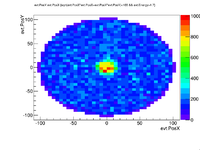 |
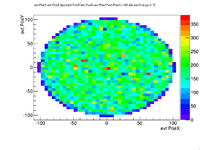
|
| 100 mm hole | 50 mm hole | 10 mm | 5 mm | 1 mm |
Peak
A projection is made along the X-axis with the cuts
- radius < 100 cm
- Energy > Source energy (0.89 or 1.7 MeV)
